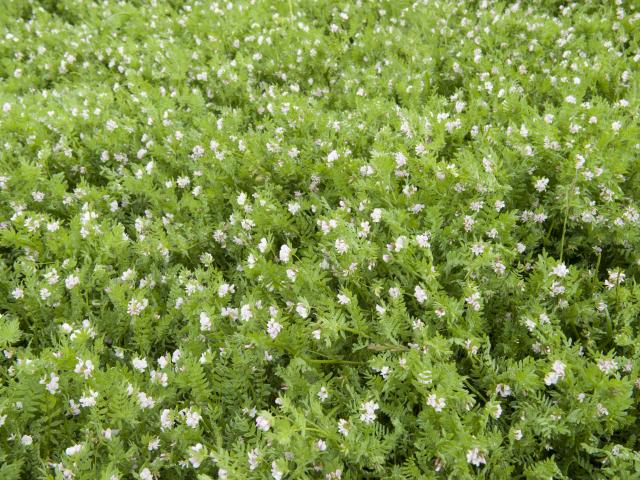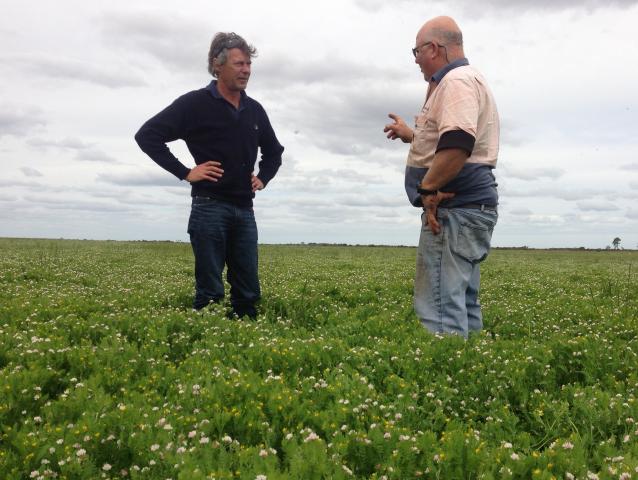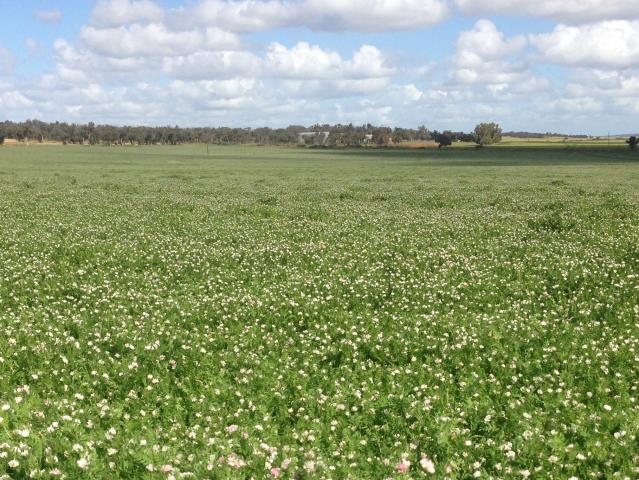History and cultivars
French serradella is an annual legume that has been used for several centuries as a fodder and green manure in the Iberian Peninsula, Atlantic Islands and central Europe. More recently it has been introduced and cultivated in the Mediterranean climatic zones of Australia and South Africa. Cadiz, Margurita and Erica are French serradella cultivars specifically bred for the 325-600mm rainfall zone in southern Australia.
Cadiz was developed from a direct introduction collected in 1989 in the Western Cape Province, South Africa, near the town of Darling (33º 22' S; 18º 22' E). This region has a Mediterranean climate similar to the south-west of Australia. Cadiz was first grown by the Australian Trifolium Genetic Resource Centre (ATGRC) under the collection code 89ZAF5SAT in 1991.
Erica and Margurita were developed by Department of Primary Industries and Regional Development (DPIRD) research officer Dr Bradley Nutt, from Cadiz as single plant selections with the ability to produce hardseeds. They were tested under the breeder’s codes FHS3 and FHS7 at a number of sites in Western Australia, NSW and Victoria. Dr Nutt also developed Eliza a soft seeded early maturing genotype of French serradella. The characteristics of these cultivars are shown in Table 1 below.
| Cultivar | Status in Australia | Hard seed | Days to flowering, Perth WA |
|---|---|---|---|
| Cadiz | PBR (1996) | No | 110 |
| Erica | Yes | 115 | |
| Margurita | PBR (2002) | Yes | 114 |
| Eliza | PBR (2010) | No | 90 |
Description
French serradella is a leguminous herb that grows as a rosette initially and then develops runners or vines as flowering is initiated. The leaves alternate along the vines and are composed of paired leaflets along the petiole, ending in a single leaflet. The flowers are formed in a cluster, usually of up to eight flowers each and are most commonly light pink.
Each flower produces a pod consisting of six to seven segments, with slight constrictions between them. The pods are 3-3.5cm long, straight or slightly curved and have a small beak at the end that may be slightly hooked. Pod segments each contain a single seed and separate freely at maturity.
In Perth, Eliza, Cadiz, Erica and Margurita begin flowering between 90-115 days after an early May sowing. Flowering tends to be earlier in more northerly districts and later in more southerly districts from a similar sowing time. Cadiz, Eliza and Margurita are upright cultivars, while Erica is more prostrate in growth habit.
Seed characteristics
Individual seeds are 1.5mm long and coloured brown in Cadiz and Eliza and yellow to cream for Erica and Margurita.
Cadiz and Eliza seed is generally fully soft-seeded at plant senescence. This means that newly ripened seed is ready to germinate and does not require removal from the pod or scarification. However Cadiz seeds are prone to losses following germination from false breaks. It also means that Cadiz will not persist for more than one season without seed production. Therefore re-sowing is required after cropping or after seasons with poor seed production.
Erica and Margurita are hard seeded cultivars. Newly ripened seeds generally have high levels of hard seed and require dehulling and seed scarification to enhance germination prior to sowing for dense pasture establishment. Unprocessed pod of these cultivars could be sown in the preceding year or over summer to utilise natural hard seed breakdown. However, more research and experience is required to develop and evaluate this technique.
Adaptation
Cadiz, Erica and Margurita are suited to regions with 325-500mm annual rainfall. Eliza is suited to regions with 250-400mm annual rainfall. French serradella is a very acid-tolerant species and is generally adapted to a range of soil textures provided pHCa is below 7.5.
Iron deficiency restricts growth at higher pH causing the leaves to develop a distinctive yellow appearance. On very poor coarse-textured soils potassium deficiency can develop particularly in the earlier stages of growth. This shows as yellowed or burnt leaf margins on the older leaves and the leaflets easily detach from the petioles with slight disturbance. French serradella can tolerate short periods of waterlogging but not inundation.
Productivity
Spring herbage yields of French serradella in Western Australia can be as high as 10t/ha and compare well with those of yellow serradella, biserrula and subterranean clover. French serradella produces high quality forage in terms of crude protein (19-25%) and dry matter digestibility (70-80%), which equates to metabolisable energy of 10-12MJ/kg DM.
It is suitable for hay or silage production, either alone or in mixtures with oats or ryegrass. Care needs to be taken when turning and baling French serradella hay to avoid leaf drop. This is best done during early morning, early evening or under humid conditions.
French serradella has a deep root system (over 2m in sandy soils) and can access deeper moisture and nutrients than the shallower-rooted annual clovers and medics. In deep coarse-textured soils this can result in an extra 2-6 weeks of green feed in late spring or early summer compared to these species.
French serradella is a prolific seed producer with yields ranging from 500-1000kg/ha of clean pod. The actual seed content of pod is usually 50-55% in Cadiz and Eliza and 60-65% in Erica and Margurita.
Use in farming systems
Eliza and Cadiz are soft seeded therefore, their self-regenerating capacity is limited. However, seed can be produced easily on-farm, particularly in good seasons, and stored for regular resowing. Being highly germinable in the pod, it does not require the additional cost of processing to remove the seed from the pod and scarification. It can therefore be used in different ways depending on the farming system, particularly when a low cost seed source is required.
Cadiz is popular in ‘phase farming’ systems as part of a strategy to control herbicide resistant crop weeds on sandy soils. In this scenario, Cadiz is sown and used as grazed pasture for one to two years. Weeds are controlled during the pasture phase through a combination of grazing, applications of non-selective herbicides (brown manuring), cutting (for example, for hay or silage production) or cultivation (green manuring). Experience so far suggests Cadiz seed viability can be maintained for a number of years (up to four years) under good storage conditions.
Productive Cadiz pastures fix substantial amounts of nitrogen for following crops and improve soil health. Nitrogen content of the plant tops ranges between 2.5-4%. Erica and Margurita are hard-seeded varieties and can survive intensive crop rotations given adequate seed production (for example, one pasture:one crop).
The proportion of hard-seed at the start of summer can be up to 90% then starts to decrease towards the end of the summer reaching values of 40-60% by midwinter. This particular pattern of hard seed breakdown avoids high amounts of germination on un-seasonable rainfall events. The persistence of hard seed across seasons will be sufficient to regenerate as a second year pasture or after one year of crop. In most situations Margurita has a greater rate of hard-seed breakdown than Erica.
| Cultivars | Seed produced in establishment year (kg/ha) | Regeneration in the second year (plants/m2) | Regeneration after one year crop (third year) (plants/m2) |
|---|---|---|---|
| French serradella - Cadiz | 381 | 2059 | 0 |
| French serradella - Erica | 581 | 728 | 3733 |
| French serradella - Margurita | 374 | 1328 | 4289 |
| Yellow serradella - Santorini | 1313 | 111 | 1333 |
| Subterranean clover - Dalkeith | 181 (seed) | 506 | 2778 |
New pasture establishment
As with other pasture legumes, French serradella should be treated as a seed crop in its first season to ensure maximum seed production. Spraytop the paddock in the previous spring or select a paddock coming out of a cereal or oil seed crop where broadleaf weeds have been successfully controlled.
Apply a knockdown herbicide after weed emergence and prior to sowing. In high rainfall regions, delay sowing to achieve good weed control with the knockdown herbicide. In low rainfall regions, decrease weed burden in the previous season then sow French serradella as close to the break of season as possible.
French serradella will usually nodulate in soils with a previous history of lupin crops or pastures. However, it is recommended that seed for sowing be inoculated with Group S inoculant. This can be done by the peat slurry and lime pelleting technique (see related information on inoculating pasture legumes), or by using Group S dry granular inoculants at the recommended rate.
Recommended sowing rates are 10-20kg/ha of pod for Cadiz and Eliza and 3-7kg/ha of naked seed for Erica and Margurita. These rates may be decreased when sowing as a component of a pasture mixture. For optimal establishment, French serradella should be sown shallow (1-2cm depth). This is best achieved by drilling with a tine or disc implement. However, dropping seed on the surface and covering with trailing harrows can also be successful. In most situations establishment is improved with the use of press wheels when drilled, or rollers if top dressed and harrowed. Fertilise new sowings of serradella with at least 150kg/ha of superphosphate, or super-potash on sandy soils.
Pests and diseases
It is important in the establishment year to control redlegged earth mite until plants have at least three true leaves. After this stage French serradella has good tolerance to these pests. French serradella has excellent tolerance to aphids such as blue-green and cowpea aphid and these are not expected to be serious problems or require control. However, native budworm (Helicoverpa caterpillars) and western flower thrip (Frankiniella occidentalis) can severely affect seed production.
Damage by thrip infestation appears as wilted and brown flowers and the pods develop with bent distortion. The damage by budworm appears as holes eaten through the sides of the pod.
On finer textured soils, lucerne flea can cause serious damage at the seedling stage. In new sowings the best way to deal with pest problems is frequent monitoring and timely control. Self-regenerating stands tend to be more resilient. However, monitoring for major pests, particularly budworm in spring, is highly recommended.
No serious diseases have been observed on serradella in Australia. Root rot can occur in waterlogged soils and there have been rare cases of hypocotyl rot (Pleiochaeta). It is not susceptible to clover scorch or phoma black spot.
Herbicides
Broadstrike®, Spinnaker® and Raptor® are registered herbicides for broadleaf weed control in French serradella. Grass weeds can usually be controlled with a selective grass herbicide. Agronomic advice should be sought to receive the most up-to-date herbicide information. Excellent control of problematic weeds, such as wild radish and annual ryegrass, has been achieved through the application of non-selective herbicides applied with a wick or blanket wiper when the weeds emerge above the height of the serradella.
Grazing
Graze the pasture lightly in the establishment year, removing stock in early spring to maximise seed production. Lightly graze over the summer to reduce the stubble. Cadiz and Eliza seed, being soft-seeded, does not survive ingestion by grazing animals, while up to 20% of Erica and Margurita seeds may survive passage through sheep and considerably more through cattle.
In later years, it is essential to graze the pasture heavily during winter to maintain a serradella dominant pasture. During spring, grazing pressure should be reduced to encourage good seed production. No livestock disorders have been associated with French serradella in Australia.
Seed harvesting
French serradella can be easily harvested using a conventional (standard or rotary drum) open front grain harvester, preferably with a finger reel. The machine settings are similar to those for wheat, except the drum speed should be at a minimum and air strenght reduced to about half. Erica and Margurita pods require dehulling and scarifying to overcome their hardseededness for high rates of germination.
Production and marketing
Cadiz, Margurita and Eliza are protected under the Plant Breeders Rights Act 1994. Under the Act there is no restriction on producing seed for personal use (farmer’s privilege) or from sale of produce, such as hay or silage. However, sale of Cadiz, Margurita and Eliza seed can only be carried out by agreement with the current licensees.
Unauthorised propagation of seed for commercial purposes or sale of these varieties is an infringement under section 53 of the Plant Breeders Rights Act 1994 and is subject to prosecution.
Strengths of French serradella
- Select between hard seeded and soft seeded cultivars for different farming systems
- Reliable effective nodulation
- Ease of seed collection and cleaning with conventional equipment
- High dry matter and seed yields
- Acid tolerance (4.0< pHCa <7.5)
- Good tolerance to redlegged earth mite and aphids
- Very palatable to stock and high nutritive value
- No major anti-nutritional properties
- Adapted to deep infertile, coarse textured soils
- Deep rooting and produces an extended green feed period compared to most annual legumes
- Useful pasture in integrated weed management strategies
Weaknesses of French serradella
- Limited broadleaf weed control options with selective herbicides
- Highly susceptible to budworm during seed production
- Some susceptibility to lucerne flea
- Unsuitable for high pH and lime (calcium) rich soils
Acknowledgments
Cadiz was developed in a collaborative project between DPIRD and the Cooperative Research Centre for Legumes in Mediterranean Agriculture (CLIMA), with part funding from the Rural Industry Research and Development Corporation.
Erica and Margurita were bred by DPIRD and field tested as part of the National Annual Pasture Legume Improvement Program, partly supported by the Grains Research and Development Corporation and Australian Wool Innovation Pty Ltd. Eliza was developed by Murdoch University’s PhD candidate Bradley Nutt, also employed by DPIRD.



